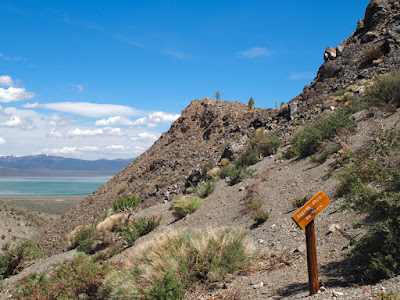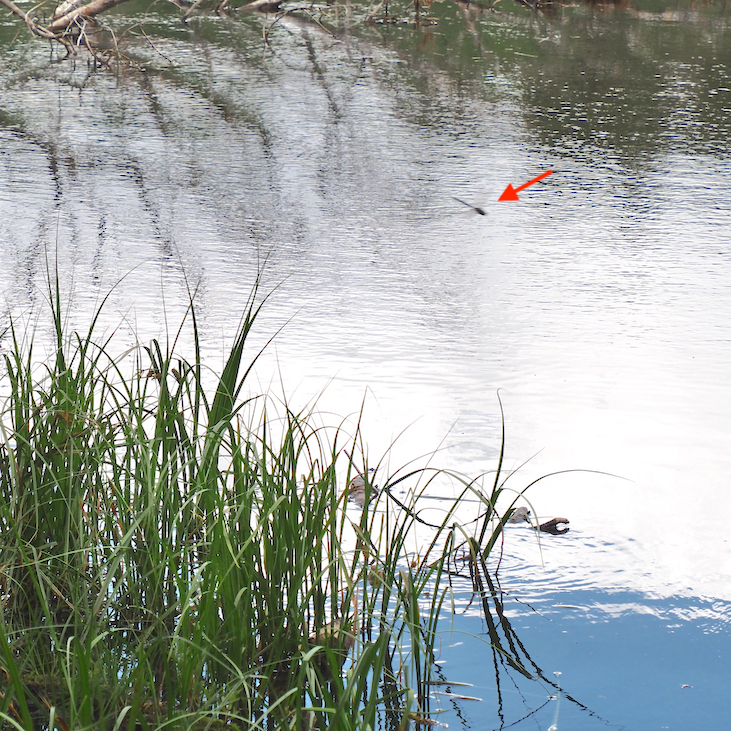 |
| Panum: phreatic, pyroclastic, Strombolian, or extruded? Answer: all of the above (Google Earth 2019). |
 |
| "Pa-num, in the Pa-vi-o-osi [local Paiute] language, means a lake" explained geologist Israel Russell in 1889. |
 |
| Mono Craters (Russell 1889). |
From Highway 120, about three miles northeast of the junction with Highway 395, a signed and passable dirt road led north to a parking area at Panum's base. It was empty except for the interpretive sign, whose explanation differed from what I had read, probably in the interest of simplification. Panum may be young, but already its life story is complicated.
 |
| North-facing sign, protected from damaging sunlight; note 6 stages at bottom. |
Geologists have long found Panum interesting, starting with Israel C. Russell in the 1880s. Later, a pumice quarry on its south side revealed much of the local stratigraphy (layers of deposits), making it relatively easy to identify and sequence the various events. Also Panum is far enough away from other Mono volcanoes that its deposits are not mixed up with theirs. The verdict? Panum has experienced five distinct eruptions!
Because Panum has been so well-studied, Sieh & Bursik (1986) chose to describe and discuss its full evolution in their paper about the Mono Craters. Their treatment is thorough! Evidence included below is from that paper unless otherwise noted. But the story here is based on the very helpful USGS field guide to Panum, which nicely summarizes Sieh & Bursik's findings.
In Panum's first eruption, on a relic lakebed of ancient Lake Russell (Mono's ancestor), a tremendous blast of steam carrying lakebed sediments opened a vent and created a crater. Probably the rising magma heated groundwater to steam. Add gases released during decompression of the magma (like opening a bottle of champagne) and voilá—a phreatic eruption! Massive deposits of broken rock from the new vent ("throat-clearing breccia") and lake sediments have been found as far as a half mile from today's crater, attesting to the violence of that first eruption.
This was followed by a pyroclastic eruption, like the one that produced the Bishop tuff and Volcanic Tableland of my previous post. These are quite violent, very different from familiar creeping basalt lavas (e.g., Hawaii's). Instead, explosive eruptions send extremely hot (1500+º F) incandescent flows of ash, fragments and gas racing across the landscape, searing everything in their path. When they stop, they cool to form distinctive deposits called ignimbrites (L. fire rain!). Scattered deposits from this episode have been found all around today's Panum.
 |
| Volcanic Tableland (right) is the product of a recent immense pyroclastic eruption; Panum upper left (Google Earth 2019). |
The third eruption probably produced a dome similar to today's. Degassing during the pyroclastic second eruption would have made the remaining magma so viscous that it could only be squeezed out of the vent (toothpaste is a common analogy). But it didn't last. Collapse of this dome explains deposits of large rock fragments north and west of Panum.
The Panum we know—both the crater and dome—was built during two recent eruptions. These were similar to earlier ones but probably less violent. We were able to experience some of this recent history via Panum's hiking trail.
 |
| Hiking the rim, with views of the dome (left) and crater below. |
Along the trail were occasional polished pebbles and gravel from the Sierra Nevada. Before Panum's birth, they had been deposited by Rush Creek where it entered Pleistocene Lake Russell. During the fourth eruption, they were gathered up by the rising magma, thrown into the air, and deposited along with volcanic fragments to form the rim.
 |
| Stream pebbles and magma fragments. |
 |
| A Sierra Nevadan granitic pebble. |
From the rim, we followed the trail down into the crater and then up to the summit of Panum's most recent creation—another dome. Once again, viscous degassed magma slowly oozed from the vent to create a silicic lava dome, i.e., greater than ~63% SiO2.
 |
| View from rim across crater below toward Panum's splintered dome. |
 |
| Up out of the crater moat, headed for the dome summit; Mono Lake in distance. |

 |
| Flow banding in the silicic lava of Panum's dome. |
Amazingly, gorgeously glassy deep black obsidian is made of the same stuff! It also cooled rapidly, but in this case there were no bubbles. Either the magma had remained pressurized while it cooled or somehow lost all its gas.
 |
| Obsidian among pumice fragments. |
 |
| Obsidian, flow banding, and a bit of breadcrust lower right—such a great combo! |
 |
| Breadcrust—escaping gas expanded the hot interior of a flow, causing the cooled surface to crack. |
 |
| Another of Panum's masterpieces. |
What does the future hold for Panum? Sieh & Bursik concluded that its recent eruptions are indeed recent—dating from sometime between A.D. 1325 and 1365. They also noted that the fourth (Strombolian) eruption lasted no more than several months. Considering the amount and extent of deposits, that must have been an exciting time! Could it happen again?
Whether California's recent volcanoes are done or only dormant is a popular topic. Dormancy seems to be the more common conclusion. Sharp & Glazner note that Panum is "just a baby" and likely still developing. The much bigger domes to the south "must have looked something like [Panum] in their infancy."
Given our all-too-brief lives, it's possible that we've simply caught Panum between events. Or perhaps we're in the middle of one, as Israel Russell mused in 1889 (if only today's papers were so philosophical!). We may think we're looking at past volcanic activity but "... it is evident that we are comparing the events of a day with a whole volume of history. Could we look into the future with as much accuracy as we are able to review the past, it would be evident that changes are now in progress that in time will equal the apparent revolutions which occurred [earlier]".
Sources
Russell, I.C. 1889. The Quaternary history of Mono Valley, California, in USGS Annual Report 8:267–438. PDF
Sharp, RP, and Glazner, AF. 1997 (2003). Geology Underfoot in Death Valley and Owens Valley. Mountain Press Publ.
Sieh, K., and Bursik, M. 1986. Most recent eruption of the Mono Craters, eastern central California, J. Geophys. Res. 91(B12):12539–12571.
USGS. Long Valley Caldera Field Guide - Panum Crater








































